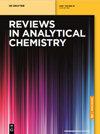Alternative analytical methods for ibrutinib quantification in pharmaceutical formulation: A statistical comparison
IF 3.8
3区 化学
Q2 CHEMISTRY, ANALYTICAL
引用次数: 1
Abstract
Abstract Ibrutinib is a drug used for the treatment of marginal zone lymphoma, mantle cell lymphoma, lymphocytic leukemia, chronic graft, and Waldenstrom macroglobulinemia. A simple, sensitive, and fast liquid chromatographic and spectrophotometric method for the quantification of ibrutinib in pharmaceutical forms and bulk was developed and validated. The chromatographic technique was developed using an ODS 3 C 18 (250 mm × 4.6 mm i.d., 5 µm) column. The mobile phase was a mixture of 0.1% trifluoroacetic acid in water and acetonitrile (50/50, v/v) at a flow rate of 1.0 mL·min−1. Eluent detection was carried out at a wavelength of 260 nm using a ultraviolet detector. The retention time of ibrutinib was found to be 5.27. On the other hand, Ibrutinib was determined using a spectrophotometric technique by measuring the absorbance of the solutions at a wavelength of 260 nm. The developed techniques were validated in accordance with the protocols outlined in International conference on harmonisation of technical requirements for registration of pharmaceuticals for human (ICH) guidelines Q2(R1). Correlation coefficients for both methods were greater than 0.999 in the concentration range of 5–30 mg·mL−1. The relative standard deviation values were low in intraday and interday precision tests. The accuracy of the developed techniques ranged 99.74–100.23% for the chromatographic method and 99.32–100.76% for the spectrophotometric method. The limits of detection and quantitation were 0.90 and 2.80 µg·mL−1 for the chromatographic method and 1.10 and 3.20 µg·mL−1 for the spectrophotometric method. The developed and validated analytical methods can be safely used in quality control tests for the determination of the amount of ibrutinib in pharmaceutical products.药物制剂中依鲁替尼定量的几种分析方法:统计比较
伊鲁替尼是一种用于治疗边缘带淋巴瘤、套细胞淋巴瘤、淋巴细胞白血病、慢性移植物和Waldenstrom巨球蛋白血症的药物。建立了一种简便、灵敏、快速的液相色谱和分光光度法定量测定依鲁替尼制剂和散装制剂的方法。色谱技术采用ODS 3c 18 (250 mm × 4.6 mm, 5µm)色谱柱。流动相为0.1%三氟乙酸水溶液与乙腈(50/50,v/v)的混合物,流速为1.0 mL·min−1。用紫外检测器在波长260 nm处对洗脱液进行检测。依鲁替尼的保留时间为5.27。另一方面,通过测量溶液在260 nm波长处的吸光度,采用分光光度法测定伊鲁替尼。所开发的技术根据国际人用药品注册技术要求协调会议(ICH)指南Q2(R1)中概述的协议进行了验证。在5 ~ 30 mg·mL−1浓度范围内,两种方法的相关系数均大于0.999。日间和日间精密度试验的相对标准偏差值较低。色谱法的准确度为99.74 ~ 100.23%,分光光度法的准确度为99.32 ~ 100.76%。色谱法的检出限和定量限分别为0.90和2.80µg·mL−1,分光光度法的检出限和定量限分别为1.10和3.20µg·mL−1。开发和验证的分析方法可以安全地用于质量控制测试,以确定药品中伊鲁替尼的含量。
本文章由计算机程序翻译,如有差异,请以英文原文为准。
求助全文
约1分钟内获得全文
求助全文
来源期刊

Reviews in Analytical Chemistry
化学-分析化学
CiteScore
7.50
自引率
0.00%
发文量
15
审稿时长
>12 weeks
期刊介绍:
Reviews in Analytical Chemistry publishes authoritative reviews by leading experts in the dynamic field of chemical analysis. The subjects can encompass all branches of modern analytical chemistry such as spectroscopy, chromatography, mass spectrometry, electrochemistry and trace analysis and their applications to areas such as environmental control, pharmaceutical industry, automation and other relevant areas. Review articles bring the expert up to date in a concise manner and provide researchers an overview of new techniques and methods.
 求助内容:
求助内容: 应助结果提醒方式:
应助结果提醒方式:


